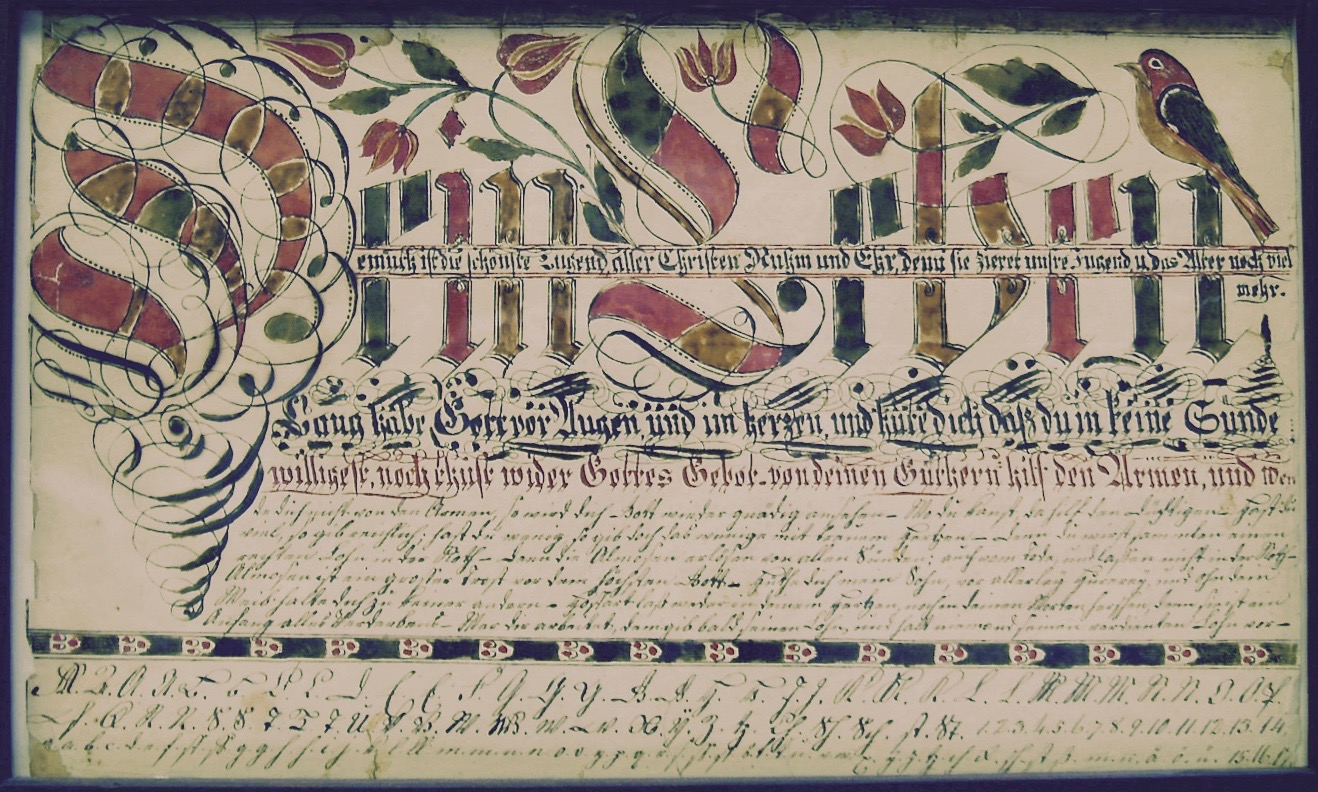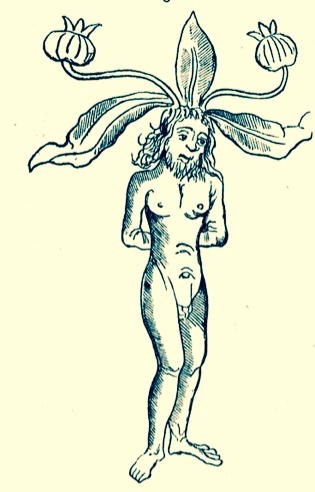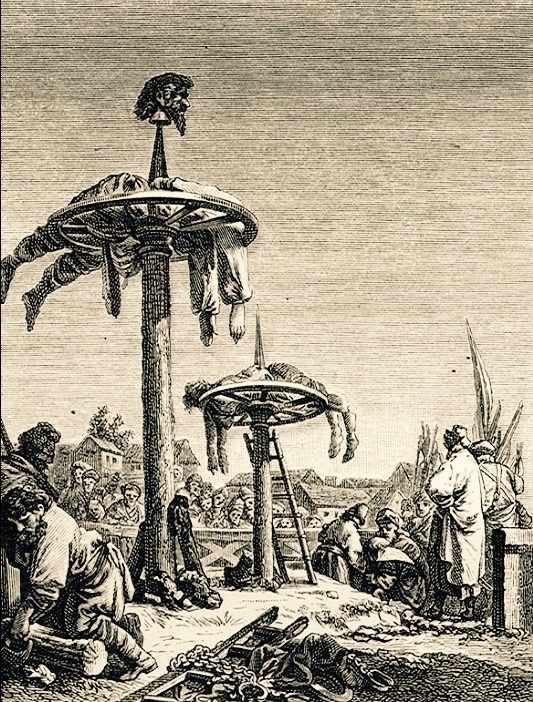- Fig. 1. Johannes E. Berkenstock Taufschein. July 30, 1830. Courtesy of David Tuttle.
According to his Taufschein, and corroborated by the birth and baptismal Reformed Church Records, 1802-1965 of the Blue Church, Coopersburg, Pa.:
Johannes E[rdman] Berkenstock was born the 30th of July in the
Year of Christ 1830, and was baptized by Mr. [Samuel] Hess
on the 23rd of September in the Year 1830. His sponsors were
Johannes Berkenstock and wife Fronica. His father the honorable
Henrich Berkenstock and wife Catharina, née Erdman. [1]
Enclosed in the top central heart is the wise counsel “Bleibe Fromm und Halte dich recht und Huete dich recht das du in keine Sünde willigest und Thust wi= der Gottes gebot [,]” or in English “Remain pious and conduct yourself properly, being cautious that you do not willingly take part in any sin and act against God’s commandment.” Similar words appear in a sermon the Chaplain of Cadolzburg, [2] namely Christian Friederich Pacius, [3] preached on August 30, 1770 at the town gallows following the executions of Conrad Süß, Johann Georg Süß, and Jacob Grund. Pacius custom designed his admonishment, taking all of Psalm 37:37 “Bleibe fromm und halte dich recht, so wird dir zuletzt wohlgehen. ” and the close of Tobias 4:6.: [Dein Lebenlang habe Gott vor Augen und im Herzen;] “Hüte dich! daß du in keine Sünde willigest, noch wissentlich wider Gottes Gebot thust” [4] to formulate an effective warning to the people of Cadolzburg.
- Fig. 2. Title Page, Church Records for Reformed Congregation at the Blue Church, Coopersburg, Pa. Courtesy of UCC Faith Church, Center Valley, Pa.
- Fig. 3. John E. Berkenstock Birth & Baptismal Entry [in pencil at bottom]. Church Records for Reformed Congregation at the Blue Church, Coopersburg, Pa., p. 4. Courtesy, UCC Faith Church, Center Valley, Pa.
- Fig. 4. Dein Leben Lang habe Gott vor Augen…Vorschrift. Courtesy of Reading Public Museum, Reading, Pa., 39.117.1.
Tobias or Tobit, a book from the Apocrypha, and included by Martin Luther in his 1545 translation of the Bible, was very popular among Lutherans both in Europe and among the Pennsylvania Dutch as words of advice to youth. It can be found on Vorschriften such as the Reading Public Museum’s “Dein Leben Lang habe Gott vor Augen,” [5] which includes not only verse 4:6 in its entirety, but also the additional verses 4:7-15.
Whereas the chaplain had a specific goal in mind when he combined the Psalm and Tobit verses, it is clear that the creator of the Berkenstock birth and baptismal certificate edited Psalm 37:37, deleting the second half of it, and, as Pacius, utilized only the second half of Tobit 4:6. Whether he had access to the gallows homily cannot be established, but if not, this scrivener may have consulted another presently unknown source. What is certain is that he utilized the message in a very different context.
- Fig. 5. Christian F. Pacius’ Gallows Sermon. Printed by the Court Printer in Onolzbach, 1770.
Chaplain Pacius’ sermon comes down to us in a copy printed in 1770, [6] the same year as the executions, by the official Court printing shop in Onolzbach for the Margraviate of Brandenburg-Ansbach where the municipality of Cadolzburg was located, and in a collection of gallows sermons [7] with a forward by Heinrich Christian Friedrich Schenk, Pastor at Mendhausen. [8] The latter was printed in Frankfurt and Leipzig in 1773, and besides the sermon also includes excerpts from the thieves’ final confessions; biographical information; and an historical account of the robberies. A short synopsis follows of the events that led up to what took place on August 30, 1770 at the Cadolzburg Gallows in Bavaria.
- Fig. 6 C. F. Pacius Sermon in H. C. F. Schenk’s Collection of Gallows Sermons, Printed in Frankfurt & Leipzig, 1773.
In 1770 Conrad Süß was age 60, and one would have thought that he could have retired comfortably. For the past twenty-eight years he had sold mandrake roots, [9] an herb that, because it grew in the shape of a man, could be sold for high prices to gullible people who believed in its supposed magical powers. However, beginning in November 1762 he took the bad advice
- Fig. 7. Mandrake Root in Shape of a Man. See: C. Schneider. Der allgemeine und Krieger-Aberglaube…Wien, 1865, 313.
of both his sons Johann, and Johann Georg, and the latter’s brother-in-law Jacob Grund, and joined them in a series of major postal coach robberies in and around Cadolzburg, and for the next several years stole not only valuables and money, but also did bodily harm to drivers and passengers. The postal coaches were under the protection of Karl Alexander (1736-1806), the last Margrave of the two Franconian principalities, Brandenburg-Ansbach and Brandenburg-Bayreuth, and it certainly was his intention, as well as of those charged with keeping travelers and their belongings safe from harm in his margraviates, to not only apprehend such criminals, but also to exact an eventual punishment of the utmost severity, one that would leave a lasting visual memory upon all of Karl Alexander’s subjects. That is exactly what happened. In 1769, finding booty from their last robbery at the home of the elder Süß in Habersdorf, authorities arrested three of the band, and took them into immediate custody. Their fate was quickly decided: On August 30, 1770 Conrad Süß was executed by the sword. A breaking wheel was then used to break his bones and mutilate his body. Finally, his head was severed and put on a pike to be displayed at the place of execution. His younger son Johann Georg was executed, and dismembered in like manner. Jacob Grund was condemned to death by the breaking wheel: With his body intertwined on the wheel, his bones were broken and he was bludgeoned to death. Such a death did not always come immediately. The condemned could linger for as long as nine days after having been clubbed with a truncheon.
- Fig. 8. Breaking on the Wheel. See: Wikimedia, Public Domain.
Some of the large crowd that had gathered to witness the executions were there for the “entertainment,” but whatever their reasons for attending, most found themselves shaken and chastened by the grizzly scene. Prior to their deaths, the chaplain at Cadolzburg Christian Friederich Pacius had been entrusted with obtaining confessions and words of repentance from the condemned as he sought to shepherd their souls to the next realm. Pacius also prepared a sermon to preach post-execution to this ready-made receptive audience: Its theme was the merit of doing good, so as to one day inherit eternal life rather than leading the ignominious and deleterious life of a thief whose final reward is most often earthly and eternal death. In closing he warned his listeners to “remain pious and conduct yourself properly, so that in the end all will be well with you. Be cautious that you do not willingly take part in any sin and act against God’s commandment.” [10]
Postlude
Sixty years later in 1830, the artist/scrivener of the Johannes E. Berkenstock Taufschein, valuing the spiritual message of these words, and far removed from time, place, or original motivation of the admonition, included them as a precept in Johannes’ birth and baptismal certificate in the traditional manner of the Pennsylvania Dutch.
Endnotes
[1] Johannes E. Breckenstock Taufschein. July 30, 1830, Lehigh County, PA.
Dimensions: 7 3/4 H x 10 W inches
Transcription [in Heart]
Bleibe Fromm | und Halte dich recht und |Huete dich recht das du in | keine Sünde willigest | und Thust wi= |der Gottes gebot
Translation [in Heart]
Remain pious and conduct yourself properly, being cautious that you do not willingly take part in any sin and act against God’s commandment.
Transcription [in cartouche below the Heart]
Johannes E. Berkenstock | ist geboren den 30sten Tag Julius | Im Jahr Christi 1830 wurde | Getauft von Hrn. Heß den 23sten September | Im Jahr 1830 seine Taufzeugen waren | Johannes Berkenstock und dessen Ehefrau | Fronica —Sein Vater ist der Ehrwürdige | Henrich Berkenstock und dessen Ehefrau Catharina | eine geboren Erdmanin.
Translation [in cartouche below the Heart]
Johannes E. Birkenstock was born the 30th of July in the Year of Christ 1830, and was baptized by Mr. Hess on the 23rd of September in the Year 1830. His sponsors were Johannes Berkenstock and wife Fronica. His father is the honorable Henrich Berkenstock and wife Catharina, née Erdman.
[2] Cadolzburg is a municipality in the district of Fürth, in Bavaria, Germany. It is situated about seven miles west of Fürth. In 2007 Cadolzburg celebrated its 850th anniversary.
[3] Hochfürstlicher Brandenburg-Onolzbach-und Culmbachischer genealogischer Kalender und Addresse-Buch auf das Jahr 1770. Ansbach bey Jacob Christoph Posch. Privil. Hof=Buch Händler, 117. Accessed 11 January 2017 http://bit.ly/2j1iQ8V.
[4] “Und dein lebenslang hab Gott fur augen und im Herzen und hüte dicht das du in keine Sünde willigst und thust wider Gottes gebot,” in Die Bibel, Apokryphe Schriften des Alten Testaments. Tobit 4:6, 1545. Accessed 10 January 2017. http://bit.ly/2j55niW.
[5] “Dein Lebenslang habe Gott vor Augen..” Vorschrift. Reading Public Museum Fraktur Collection, Reading, Pa. 39.117.1
[6] Christian Friederich Pacius. Den so schändlich als schädlichen Lohn des Raubend Betrachtete bey wohlverdienter Hinrichtung Dreier Post=Räuber…Onolzbach, gedruckt in der Hof=Buchdruckerey,1770, 4. Accessed 12 January 2017. http://bit.ly/2ih2snT
[7] Heinrich Christian Friedrich Schenk. Sammlung merkwürdiger Reden, welche auf dem Blutgerüste theils von Königen, Fürsten und Grafen, Gelehrten und Ungelehrten, gehalten worden. Frankfurt und Leipzig, 1773, 188-204. Accessed 15 January 2017.
http://bit.ly/2i7i2SM
[8] Mendhausen is a village and a former municipality in the district of Hildburghausen, in Thuringia, Germany. Since 31 December 2012, it has been part of the town of Römhild.
[9] C. Schneider. “ Der allgemeine und der Krieger-Aberglaube im 16., 17. und 18. Jahrhundert,” in Österrieichische militärische Zeitschrift. Redakteur V. Streffleur. Wien, Druck und Commisions-Verlag von Carl Gerold’s Sohn, 1865, zweiter Band, 305-337. Accessed 15 January 2017. http://bit.ly/2iv8pbZ
[10] Pacius used Psalm 37:37, and the last half of the verse from Tobit 4:6 to create this precept. In German his version reads “bleibe fromm und halte dich recht, so wird es dir zuletzt wohlgehen. Hüte dich! daß du in keine Sünde willigest noch wissentlich wider Gottes Gebot thust.
Winterthur Research Fellow, 2016-2017
Moravian and Pennsylvania Dutch Material Culture
 Every year Winterthur provides fellowships to a select group of scholars for research
in their chosen areas of study in social and cultural history, including material culture, architecture, decorative arts, design, consumer culture, garden and landscape studies, Shaker studies, travel and tourism, the Atlantic World, and objects in literature. ~ Winterthur Research Program. Thanks to a short-term research fellowship at Winterthur, I have been able to study rare books in the Winterthur Museum Library Collection of Printed Books and Periodicals; objects in the Winterthur Museum Collection; and manuscripts in the Joseph Downs Collection of Manuscripts and Printed Ephemera. All has contributed to my research for a book in progress Heavenly Fraktur: How Fraktur Influenced Pennsylvania German and Moravian Material Culture. This blog post is based on that research. My sincere thank you to all at Winterthur who have made this fellowship possible.
Every year Winterthur provides fellowships to a select group of scholars for research
in their chosen areas of study in social and cultural history, including material culture, architecture, decorative arts, design, consumer culture, garden and landscape studies, Shaker studies, travel and tourism, the Atlantic World, and objects in literature. ~ Winterthur Research Program. Thanks to a short-term research fellowship at Winterthur, I have been able to study rare books in the Winterthur Museum Library Collection of Printed Books and Periodicals; objects in the Winterthur Museum Collection; and manuscripts in the Joseph Downs Collection of Manuscripts and Printed Ephemera. All has contributed to my research for a book in progress Heavenly Fraktur: How Fraktur Influenced Pennsylvania German and Moravian Material Culture. This blog post is based on that research. My sincere thank you to all at Winterthur who have made this fellowship possible.
My thanks also to David Tuttle of David Tuttle Antiques; Bob & Kathy Exner, and Rev. James Hammond of the Blue Church, Coopersburg, Pa.; Sandy David & Rev. Dr. Bruce C. Stevenson of Faith UCC Church, Center Valley, Pa; John Graydon Smith and Scott Schweigert of the Reading Public Museum, Reading, Pa.; and Bill Dayley, Aron Heckler, and Bob Wood of the Goschenhoppen Historians, Green Lane, Pa.
A Gallows Sermon and the Johannes E. Berkenstock Taufschein Blog Post including transcriptions; translations; and photo images except for Figures 5,6,7,8 © 2017 Del-Louise Moyer.



![Fig. 3. John E. Berkenstock Birth & Baptismal Entry [in pencil at bottom]. Church Records for Reformed Church of the Blue Church at Coopersburg, Pa., p. 4. Courtesy, UCC Faith Church, Center Valley, Pa.](https://alyssumarts.com/wp-content/uploads/2017/01/3_post-15_107-alyssum-blue-church-reformed_p4_-17jan2017_v2_29_image-c2a9-dlmoyer.jpg)




